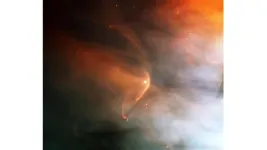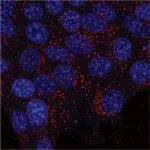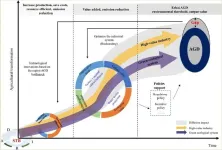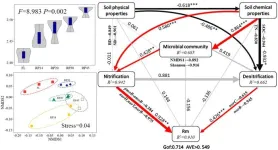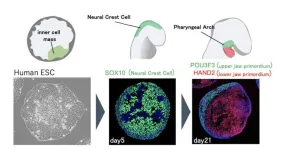(Press-News.org) An international research team led by a researcher from the University of Vienna has for the first time directly detected stellar winds from three Sun-like stars by recording the X-ray emission from their astrospheres, and placed constraints on the mass loss rate of the stars via their stellar winds. The study is currently published in Nature Astronomy.
Astrospheres, stellar analogues of the heliosphere that surrounds our solar system, are very hot plasma bubbles blown by stellar winds into the interstellar medium, a space filled with gas and dust. The study of the stellar winds of low-mass stars similar to the Sun allows us to understand stellar and planetary evolution, and ultimately the history and future of our own star and solar system. Stellar winds drive many processes that evaporate planetary atmospheres into space and therefore lead to atmospheric mass loss.
Although escape rates of planets over an hour or even a year are tiny, they operate over long geological periods. The losses accumulate and can be a decisive factor for a planet evolving into a habitable world or an airless rock. Despite their importance for the evolution of both stars and planets, winds of Sun-like stars are notoriously difficult to constrain. Mainly composed of protons and electrons, they also contain a small quantity of heavier highly charged ions (e.g. oxygen, carbon). It is these ions which, by capturing electrons from the neutrals of the interstellar medium around the star, emit X-rays.
X-ray emission from astropheres detected
An international research team led by Kristina Kislyakova, Senior Scientist at the Department of Astrophysics of the University of Vienna, has detected for the first time the X-ray emission from the astrospheres around three sun-like stars, so called main sequence stars which are stars in the prime of their life, and has thus recorded such winds for the first time directly, allowing them to place constraints on the mass loss rate of the stars via their stellar winds.
These results, based on observations with the XMM-Newton space telescope, are currently published in Nature Astronomy. The researchers observed the spectral fingerprints (so-called spectral lines) of the oxygen ions with XMM-Newton and were able to determine the quantity of oxygen and ultimately the total mass of stellar wind emitted by the stars. For the three stars with detected astrospheres, named 70 Ophiuchi, epsilon Eridani, and 61 Cygni, the researchers estimated their mass loss rates to be 66.5±11.1, 15.6±4.4, and 9.6±4.1 times the solar mass loss rate, respectively. This means that the winds from these stars are much stronger than the solar wind, which might be explained by stronger magnetic activity of these stars.
"In the solar system, solar wind charge exchange emission has been observed from planets, comets, and the heliosphere and provides a natural laboratory to study the solar wind’s composition", explains the lead author of the study, Kristina Kislyakova. "Observing this emission from distant stars is much more tricky due to the faintness of the signal. In addition to that, the distance to the stars makes it very difficult to disentangle the signal emitted by the astrosphere from the actual X-ray emission of the star itself, part of which is "spread" over the field-of-view of the telescope due to instrumental effects. We have developed a new algorithm to disentangle the stellar and the astrospheric contributions to the emission and detected charge exchange signals originating from stellar wind oxygen ions and the surrounding neutral interstellar medium of three main-sequence stars. This has been the first time X-ray charge exchange emission from astrospheres of such stars has been detected. Our estimated mass loss rates can be used as a benchmark for stellar wind models and expand our limited observational evidence for the winds of Sun-like stars."
Co-author Manuel Güdel, also of the University of Vienna, adds, "there have been world-wide efforts over three decades to substantiate the presence of winds around Sun-like stars and measure their strengths, but so far only indirect evidence based on their secondary effects on the star or its environment alluded to the existence of such winds; our group previously tried to detect radio emission from the winds but could only place upper limits to the wind strengths while not detecting the winds themselves. Our new X-ray based results pave the way to finding and even imaging these winds directly and studying their interactions with surrounding planets."
"In the future, this method of direct detection of stellar winds in X-rays will be facilitated thanks to future high resolution instruments, like the X-IFU spectrometer of the European Athena mission. The high spectral resolution of X-IFU will resolve the finer structure and emission ratio of the oxygen lines (as well as other fainter lines), that are hard to distinguish with XMM's CCD resolution, and provide additional constraints on the emission mechanism; thermal emission from the stars, or non-thermal charge exchange from the astrospheres." - explains CNRS researcher Dimitra Koutroumpa, a co-author of the study.
More space news in our science magazine Rduolphina
You can read more about space research at the University of Vienna in the article Europe in the Space Race in the University of Vienna's science magazine Rudolphina or in the overarching section Nature, Climate and the Cosmos.
END
Stellar winds of three sun-like stars detected for the first time
Astrophysicists were able to quantify the mass loss of stars via their stellar winds
2024-04-12
ELSE PRESS RELEASES FROM THIS DATE:
Iconic savanna mammals face genetic problems due to fences and roads
2024-04-12
Whether by way of Attenborough, Disney or National Geographic, the iconic scene is familiar to many. The ground trembles and clouds of dust swirl as enormous hordes of large animals thunder across the African savanna, cross rivers en masse and are picked off by lions, hyena and crocodiles. The annual migration of 1.3 million wildebeest through Tanzania’s Serengeti and Kenya’s Masai Mara attracts hundreds of thousands of tourists, and the phenomenon has put the Serengeti on UNESCO's list of World Heritage sites. Besides its majestic sight, the migration of this emblematic species ...
PFAS exposure from high seafood diets may be underestimated
2024-04-12
A Dartmouth-led study suggests that people who frequently consume seafood may face an increased risk of exposure to PFAS, the family of ubiquitous and resilient human-made toxins known as "forever chemicals."
The findings stress the need for more stringent public health guidelines that establish the amount of seafood people can safely consume to limit their exposure to perfluoroalkyl and polyfluoroalkyl substances, the researchers report in the journal Exposure and Health. This need is especially urgent for coastal regions such as New England where a legacy of industry and PFAS pollution bumps up against a cultural predilection for fish, the authors write.
"Our recommendation ...
Can TA-NRP increase the number of patients receiving lung transplants?
2024-04-12
Embargoed until 8:30 a.m. Friday, 12 April, 2024 Central European Summer Time or GMT +2
12 April, 2024, Prague, Czech Republic—Re-perfusing the lungs of an organ donor after the heart has irreversibly stopped beating with a technique called normothermic regional perfusion (TA-NRP) could potentially increase the number of patients receiving lung transplants, according to researchers at the Annual Meeting and Scientific Sessions of the International Society for Heart and Lung Transplantation (ISHLT) in Prague.
TA-NRP uses a machine to pass blood through a donor’s abdomen and chest after the heart has irreversibly stopped beating (called ...
Retention ponds can deliver a substantial reduction in tire particle pollution, study suggests
2024-04-12
Retention ponds and wetlands constructed as part of major road schemes can reduce the quantities of tyre particles entering the aquatic environment by an average of 75%, new research has shown.
The study analysed samples collected alongside some of the busiest routes in South West England and the Midlands, many used by more than 100,000 vehicles each day.
Tyre particles were discovered in each of the 70 samples taken, confirming the findings of previous research which has shown them to pose a considerable ...
Softer tumours fuel more aggressive spread of triple-negative breast cancer
2024-04-12
Softer tumours fuel more aggressive spread of triple-negative breast cancer
Researchers have discovered how the mechanical properties of tumours can prime cancer cells to better survive their spread to other organs.
A metabolic ‘survival switch’ controlled by the stiffness of triple-negative breast tumours can significantly influence how successfully their cancerous cells spread to other organs, according to new findings from the Garvan Institute of Medical Research.
The study in cell and ...
Dynamic-EC: An efficient dynamic erasure coding method for permissioned blockchain systems
2024-04-12
It's interesting to hear about the research led by Minyi Guo that was published in Frontiers of Computer Science on 12 Mar 2024. It seems like they are addressing the challenge of reducing storage overhead in blockchain systems while maintaining data consistency and tolerating malicious nodes.
In traditional blockchain networks, full replication is used, where each node stores a complete copy of all blocks, and data consistency is maintained through a consensus protocol. However, this approach can be storage-intensive, especially as the blockchain grows over time.
To address ...
How does the STB promote the coordination between environmental protection and agricultural development in Erhai Lake?
2024-04-12
Erhai Lake, covering 252 km2, located in Yunnan Province, is one of the seven largest freshwater lakes in China. However, over the last three decades, the lake has suffered pollution episodes. In order to solve this problem, the local government has taken many protective measures. These measures have achieved some results in the environmental protection of Erhai Lake, but also caused significant socioeconomic impact. The tension between environmental preservation and economic stability in Erhai has even been termed the ‘Erhai dilemma’. The ‘Erhai dilemma’ is representative of those of other lakes in Yunnan Province ...
New study uncovers the role of soil microbes in forest ecosystems
2024-04-12
Assessing the function of forest ecosystems requires a deep understanding of the mechanisms of soil nitrogen mineralization. A recent study conducted by a team of researchers has shed light on how soil N-cycling genes drive soil nitrogen mineralization during afforestation. The findings, published in the prestigious journal Soil Ecology Letters, provide valuable insights into the relationship between soil microbial communities, functional genes, and the rate of soil nitrogen mineralization.
The researchers collected soil samples from a chronosequence of Robinia pseudoacacia L (RP14, RP20, RP30, and RP45) at different stages of afforestation, along with a sloped farmland (FL) as ...
Cells putting on a face
2024-04-12
Kyoto, Japan -- Mother Nature is an artist, but her craft of creating animal faces requires more than a paintbrush and palette. Such highly complex shapes originate from their respective transient neural crest cells.
These embryonic pluripotent cells within the facial primordium—the early development form—may be necessary for forming proper facial structures. However, analyzing the molecular mechanisms in such early stages of development poses many technical challenges.
Now, a group of Kyoto University researchers have produced neural crest cell-rich ...
First clinical trial of vosoritide for children with hypochondroplasia shows increased growth
2024-04-12
WASHINGTON (April 11, 2024) – Vosoritide’s first global phase 2 study showed an average increased growth rate of 1.8 cm per year in children with hypochondroplasia, a genetic cause of short stature in children, according to researchers from Children’s National Hospital.
“This is the first medicine that has been developed to specifically target the pathway involved in hypochondroplasia,” says Andrew Dauber, M.D., chief of Endocrinology at Children’s National. “These findings will help inform future studies of vosoritide for addressing growth disorders.”
This clinical trial ...
LAST 30 PRESS RELEASES:
Numbers in our sights affect how we perceive space
SIMJ announces global collaborative book project in commemoration of its 75th anniversary
Air pollution exposure and birth weight
Obstructive sleep apnea risk and mental health conditions among older adults
How talking slows eye movements behind the wheel
The Ceramic Society of Japan’s Oxoate Ceramics Research Association launches new international book project
Heart-brain connection: international study reveals the role of the vagus nerve in keeping the heart young
Researchers identify Rb1 as a predictive biomarker for a new therapeutic strategy in some breast cancers
Survey reveals ethical gaps slowing AI adoption in pediatric surgery
Stimulant ADHD medications work differently than thought
AI overestimates how smart people are, according to HSE economists
HSE researchers create genome-wide map of quadruplexes
Scientists boost cell "powerhouses" to burn more calories
Automatic label checking: The missing step in making reliable medical AI
Low daily alcohol intake linked to 50% heightened mouth cancer risk in India
American Meteorological Society announces Rick Spinrad as 2026 President-Elect
Biomass-based carbon capture spotlighted in newly released global climate webinar recording
Illuminating invisible nano pollutants: advanced bioimaging tracks the full journey of emerging nanoscale contaminants in living systems
How does age affect recovery from spinal cord injury?
Novel AI tool offers prognosis for patients with head and neck cancer
Fathers’ microplastic exposure tied to their children’s metabolic problems
Research validates laboratory model for studying high-grade serous ovarian cancer
SIR 2026 delivers transformative breakthroughs in minimally invasive medicine to improve patient care
Stem Cell Reports most downloaded papers of 2025 highlight the breadth and impact of stem cell research
Oxford-led study estimates NHS spends around 3% of its primary and secondary care budget on the health impacts of heat and cold in England
A researcher’s long quest leads to a smart composite breakthrough
Urban wild bees act as “microbial sensors” of city health.
New study finds where you live affects recovery after a hip fracture
Forecasting the impact of fully automated vehicle adoption on US road traffic injuries
Alcohol-related hospitalizations from 2016 to 2022
[Press-News.org] Stellar winds of three sun-like stars detected for the first timeAstrophysicists were able to quantify the mass loss of stars via their stellar winds
